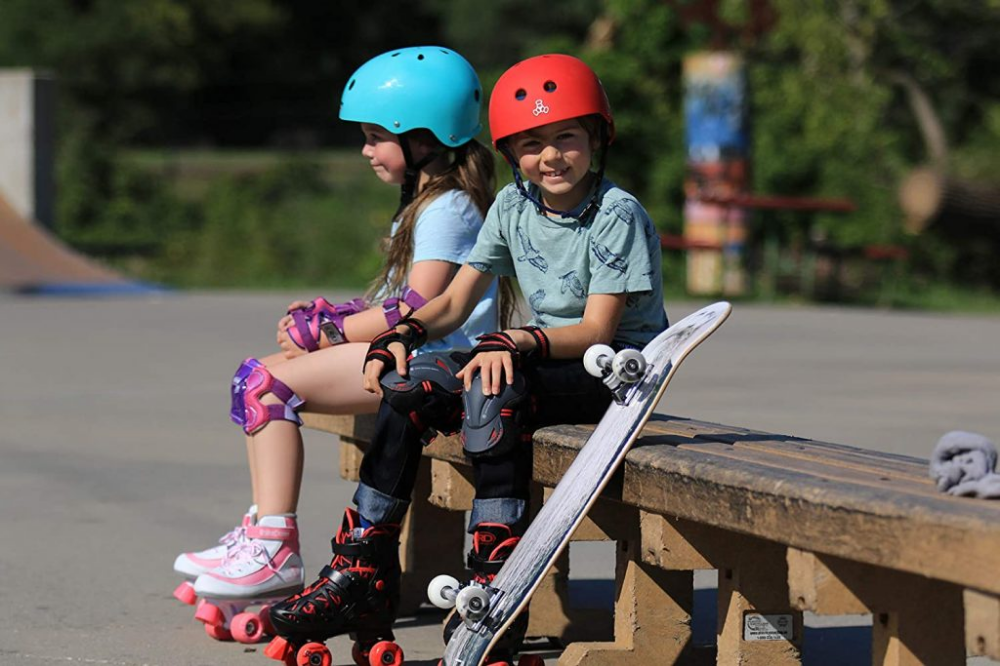
Getting Kids Started With Roller Skates
This page contains affiliate links for which we may be compensated
Last updated: July, 2024
Roller skating is not just a fun activity; it’s also a fantastic way to encourage physical fitness and develop balance and coordination in children. However, introducing your child to roller skates can seem daunting if you’re unsure where to begin. Here we will guide you through the process of getting kids started with roller skates, ensuring a safe and enjoyable experience for both you and your little one.
Choosing the Right Roller Skates
Before diving into the world of roller skating, it’s essential to select the right pair of skates for your child. Opt for adjustable skates that can grow with your child’s feet, providing a snug and secure fit. Look for skates with supportive ankle padding and sturdy wheels suitable for outdoor or indoor skating, depending on your preference. From inline skates to classic four-wheel skates, there are options to fit every age and skill level.
Start Slow: Learning the Basics
Teaching your child to roller skate requires patience and encouragement. Begin in a safe and spacious area free of obstacles, such as a smooth driveway, empty parking lot, or a local roller rink. Encourage your child to practice standing on the skates, maintaining balance, and taking small steps forward. Holding onto your hand or a stable object, such as a wall or railing, can provide additional support as they gain confidence.

Mastering Balance and Coordination
As your child becomes more comfortable on their skates, encourage them to practice basic movements, such as gliding, stopping, and turning. Emphasize the importance of maintaining a bent knee position and keeping their weight centered over their skates to improve balance and stability. Cheer them on as they achieve small milestones, fostering a sense of accomplishment and motivation to continue learning.
Fun and Games: Making Learning Enjoyable
Incorporating games and activities into your child’s roller skating practice can make the learning process more enjoyable. Set up obstacle courses using cones or markers to improve agility and maneuverability. Play follow the leader, taking turns leading movements and encouraging creativity on skates. Remember to keep the atmosphere light-hearted and fun, reinforcing a positive association with roller skating.
Practice Makes Perfect: Consistency is Key
Like any skill, mastering roller skating requires consistent practice and dedication. Encourage your child to skate regularly, gradually increasing the duration and intensity of their sessions as they become more proficient. Celebrate their progress along the way, acknowledging their efforts and achievements to keep them motivated and engaged.

Roller Skating Safety Tips
While roller skating can be a thrilling and enjoyable activity for children, it’s essential to prioritize safety to prevent accidents and injuries. Here are some important safety tips to keep in mind when your child is roller skating:
- Wear Protective Gear: Ensure your child wears the necessary protective gear every time they skate, including a properly fitting helmet, elbow pads, knee pads, and wrist guards. These items provide vital protection against falls and collisions, reducing the risk of serious injury.
- Choose the Right Skates: Select roller skates that fit your child comfortably and provide adequate ankle support. Avoid skates that are too loose or too tight, as they can affect stability and increase the risk of accidents. Consider adjustable skates that can accommodate your child’s growing feet.
- Find a Safe Skating Area: Choose skating locations that are flat, smooth, and free of obstacles, such as cracks, rocks, or debris. Opt for designated skating areas, such as indoor or outdoor skating rinks, parks, or paved trails, where your child can skate without interference from traffic or pedestrians.
- Practice Balance and Control: Encourage your child to practice basic skating skills, such as maintaining balance, stopping, and turning, in a controlled environment. Start with slow, small movements and gradually increase speed and complexity as their skills improve. Emphasize the importance of bending their knees and keeping their weight centered over their skates to maintain stability.
- Stay Alert and Aware: Teach your child to stay alert and aware of their surroundings while skating. Remind them to watch out for obstacles, other skaters, and changes in terrain that could pose a risk. Encourage them to skate defensively and anticipate potential hazards to avoid accidents.
- Follow Traffic Rules: If skating outdoors, teach your child to obey traffic rules and signals, such as stopping at intersections, yielding to pedestrians, and staying to the right side of the path or trail. Emphasize the importance of skating in a controlled manner and avoiding sudden movements or erratic behavior that could surprise others.
- Use Proper Technique: Teach your child proper skating techniques, such as using their arms for balance, maintaining a slight bend in their knees, and keeping their eyes focused forward. Encourage them to skate with confidence and control, using smooth and deliberate movements to navigate obstacles and terrain.
- Know When to Take Breaks: Encourage your child to take regular breaks during skating sessions to rest and rehydrate. Watch for signs of fatigue or discomfort, such as heavy breathing, sweating, or loss of coordination, and encourage them to take a break if needed to prevent overexertion and injury.
Conclusion
Introducing your child to roller skating is an exciting journey filled with laughter, learning, and growth. By choosing the right equipment, prioritizing safety, and providing patient guidance and encouragement, you can set your child up for success on wheels. Embrace each milestone with pride and enthusiasm, knowing that you’re instilling valuable life skills and creating cherished memories that will last a lifetime. So lace up those skates, hit the pavement, and watch your child soar!